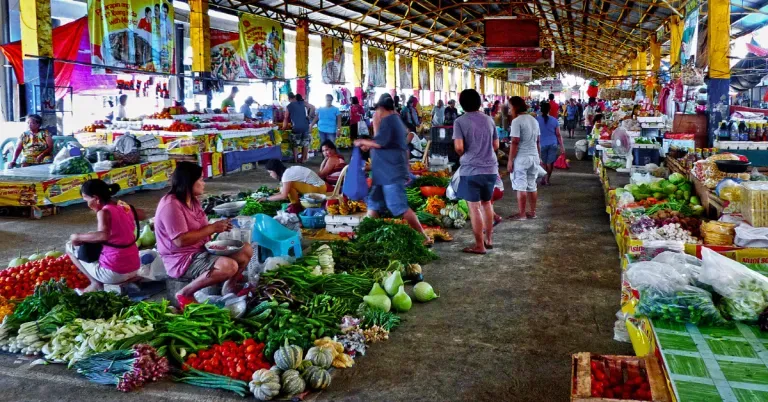Our favourite places to stay on this sleepy Cebu island.
Palengke Tips: 13 Public Market Hacks for Newbie Shoppers

Every time you cook, you want only the best ingredients for your dish. Sure, you can head to your nearest supermarket and grab what you need. But, if you’re aiming for the freshest and cheapest ingredients, your best bet would be the wet public markets or palengke.
Those who’ve tried palengke shopping know that the voyage is easier said than done. It takes some experience to navigate through these markets like a pro, and if you’re coming in alone without a palengke-expert by your side, you might have a hard time.
These questions are often our concerns: How do I know if I’m getting the freshest fish? Which part of meat do I get for my dish? What does it mean when aling tindera says sitenta y nueve?
If you’re looking to master the public markets’ tricks of the trades, we have you covered. When you decide to go on a quest for ingredient-hunting, make sure that you bring these palengke tips with you!
Also read: Public Markets Should Be on Your Itineraries — Here’s Why
How to navigate through your palengke: tips for the newbie
1. Write an organised things-to-buy list

Every meticulous market-goer will always have a list of items to buy. A list will help you in two significant ways. First, it’ll allow you to plan your items ahead of time, preventing you from impulsive shopping for things you don’t even need. Without a list, you’ll likely buy more recklessly; sometimes, you might even forget some necessary ingredients. Second, you can save more time in the market by grouping items of the same category: condiments, meat, fish, vegetables, et cetera.
2. Establish a weekly meal plan

If you have a refrigerator, then bulk palengke shopping can help you save time. Make a weekly meal plan to avoid heading to the marketplace every day. This way, you can get all the things you’ll need for the week. Tinderas are also more likely to give you a discount when you buy items from them in bulk.
3. Buy items in a spoil-free order

When buying in a wet market, the rule of thumb is to prioritise items that don’t perish quickly. Buying things in order is especially crucial if it’ll take you hours to get home. Buy condiments first, like soy sauce, vinegar, or seasonings. Consider asking the store to hold on to your purchases first so you won’t have to carry them around. Just don’t forget to get it back before you leave! After buying your sauces, go to your market’s fruit and vegetable stands and grab what you need.
Next, head over to the meat section and buy what you need. Your final trip must be for the fish and seafood section since these spoil quickly without ice.
4. Bring your own container

The true OG palengke masters bring bayongs, or their modern counterpart, eco-bags. Having your own containers makes carrying around your purchased items much more manageable. Not only that, but you’ll also be helping the environment by using less plastic. Consider getting a shopping trolley bag if you see yourself buying in palengkes more often!
Also read: Really Really Free Market: An Escolta Community-Led Alt-Retail Initiative
5. Be wary of your basket arrangement

It’s not enough to bring your own container. You must also know how to arrange the items in your basket properly! For example, put heavier objects (e.g. meat, condiments) at the bottom of your bag, and layer the fragile ones (e.g. veggies, fish) on top.
6. Find your trustworthy suking tindera

If you plan on buying in your local market regularly, it’s best to build a rapport with some vendors. Then, they’ll be more willing to give you, as their suki, discounts. They may even give you the best and freshest items in the bunch.
You can start small talk and ask them about their background — their families, where they’re from, et cetera. You can also ask them for some in-house palengke tips!
Also read: Moving Out for Millennials: 5 Things to Consider Before Getting Your Own Place
7. Let vendors know what you’re planning to cook

Different dishes require specific cuts in meats and fish, which you may have seen in supermarkets. For instance, there are particular slices for fried, stewed, or steamed chicken. Simply mention what you’re planning to cook, and they’ll do the rest. You can also ask for your preferred fish to be descaled and gutted.
8. Find the best time for your market trip

Public markets open as early as 4am to 5am in some areas. The earlier you get there, the better options you have. Meat and fish are fresher during the day. In the afternoon, you’ll likely be buying the pinagpilian or items that aren’t chosen by buyers who came before you.
9. Avoid buying out-of-season fruits and veggies

You’ve probably heard this palengke tip before. Unless your naglilihing pregnant family or friend is looking for a specific taste, it’s best to do away with fruits and vegetables that aren’t in season. This is because the prices of fruits in the months outside of their peak harvest season are often higher than usual.
10. Dress appropriately

Avoid staining your white clothes! The best palengke getup is the clothes you wear at home — simple and worry-free. Plus, if you come into public markets looking posh, sellers might not give you much wiggle room for bargaining as you’d look like you have the capacity to pay in full.
Also read: #TravelGoals? These Adulting Goals Might Be More Important
Nanay-level expert buying tips
11. Find meat dressed in red and pink

When buying pork and beef, the colour representing freshness is dark red. Avoid buying meat that is already turning brown or grey on its edges. If you can check the firmness of the meat, do it! Good meat is a little stiff and not wobbly. If it looks slimy and has a foul smell, don’t buy it.
On the other hand, the best chickens are found in pink-yellowish colours. Similar to red meat, the surface must be firm, not slimy, and free of tears. After testing a chicken’s firmness, its skin and meat must go back to its original form.
12. Look at the eyes of fish

A fresh fish is easy to spot. Just look at its eyes — if it’s clear, it’s fresh. A tell-tale sign that a fish is not fresh anymore is its red eyes. In contrast, the gills of a fresh fish are red in colour. Similar to meat, do away with slimy fish with a wobbly surface.
Extra tip: When buying mussels, look for closed ones. Open mussels are dead and are likely not fresh.
13. Check for your fruits and vegetables’ firmness

A fresh vegetable looks bright in colour and has a firm surface. Try to get a feel of its firmness and look for the stiffest ones! Also, it’s best to avoid the pre-sliced vegetables for cooking. Remember, buy fruits and veggies in their original state: fresh and untouched.
That’s it! If you’ve ever felt lost in the public markets, just go back to our palengke tips and brave your next market adventure like a pro.
Featured image credit: Bernard Spragg | Flickr
Published at
About Author
Martin Joseph Raymundo
Subscribe our Newsletter
Get our weekly tips and travel news!
Recommended Articles
10 Bantayan Island Resorts, Hotels, and Rentals for Your Tropical Escape 10 Best Banawe Restaurants for a Mouthwatering Food Trip in QC The promise of new flavours beckons from Banawe.
14 Best Credit Cards for Travel in the Philippines The only plastic we need for travel.
10 Best Mountain Cafes in the Philippines for Your Peak Coffee Experience Coffee date on the mountains, anyone?
10 Commandments for Responsible Travel Flexing Spread the good word!
Latest Articles
Rates, Packages, and What to Expect From the Disney Adventure Cruise Let the adventure begin!
Anko Philippines Store Opens Today – See What’s in Store at Glorietta 2 This holiday season, give your home an upgrade!
LRT-1 Cavite Extension Launches: Five New Stations Open November 16 Get ready for quicker commutes!
China Expands Visa-Free Access: 9 New Countries Added for 2025 Check if your country’s on the list and start planning!
Your Guide to Boyz II Men’s Manila Concert: Tickets, Venue, and More! Get ready for a night of timeless hits!

